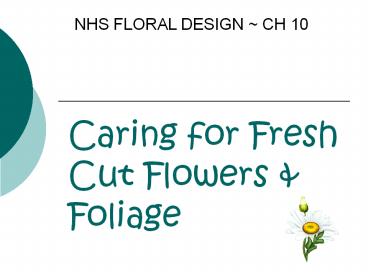Caring for Fresh Cut Flowers PowerPoint PPT Presentation
1 / 15
Title: Caring for Fresh Cut Flowers
1
Caring for Fresh Cut Flowers Foliage
NHS FLORAL DESIGN CH 10
2
Objective 1 Explain the basic requirements of
cut flowers.
- Even though fresh flowers have been removed from
plants, they continue to photosynthesize-produce
food from sunlight. In that process, there are
certain requirements.
3
Basic Needs of Fresh Cut Flowers
- High Water Quality
- Food Sugar
- Healthy Environment
- Sanitation
4
A. High Water Quality
- A flower is 90 percent water.
- Plant cells that are filled with water are called
turgid. - As the flowers continue to photosynthesize and
respire, they will need water! - A pH test will determine whether the water is
acidic, or alkaline. - If floral preservative is added to water, it will
increase the acidic level, thereby increasing
water intake in plants - Hard water will affect pH.
- Salinity needs to be less than 200 ppm
5
B. Food Sugar
- The cut flower is in need of sugars
- Most commonly sucrose and dextrose
- The flower gets these sugars through supplemental
sugars provided in a floral preservative
6
C. Healthy Environment
- Need to be in an environment free from ethylene
gas - Do not store near fruit
- Conditioning the preparation of materials for
arranging by allowing adequate solution uptake - Warm water increases uptake and contains less
trap air - Flowers should be re-cut and de-foliated to a
point that no leaves will be in the water
solution - Let water get to room temperature before putting
flowers in the cooler - Place in a cooler at 34-38º F.
- Flower coolers (versus refrigerators) control
humidity in addition to cooling
7
D. Sanitation
- Keeping the handling process sanitary will
provide flowers that will last a long time - Hands, tools, knives, shears, containers, and
work areas need to be kept sanitary - Introduction of bacteria and organisms can be
avoided by cleaning work areas, coolers, and
containers on a regular basis
8
Objective 2 To understand the causes of
deterioration and death of flowers
- When a flower is cut from the mother plant, the
deterioration process begins because the flower
no longer has a water or food source. It is up to
the human to provide a substitute. The flower
will eventually die. - This is referred to as senescence
9
Causes of Deterioration and Death of Flowers
- Genetic Life
- Wilting
- Timing of Harvest
- Ethylene Gas Exposure
- Disease or Damage
10
A. Genetic Life
- Each flower has a certain inherent life span
based on its genetics - Our goal is to achieve for each flower the
maximum life span allowed by nature - EXAMPLES
- Flower Life Span
- Daylily 1 day
- Dutch Iris 3-5 days
- Rose 5-7 days
- Carnations 10-14 days
- Chrysanthemums 14-21 days
11
B. Wilting
- Caused by either excessive water loss or lack of
absorption - Can also be caused by blocked vascular tissue
- Transpiration water loss in the process of
respiration - Often increased when flowers are in warm
environments with low humidity - Respiration process of burning glucose to
create energy - Stem Blockage most common cause of poor
absorption. The xylem becomes clogged and no
water movement can occur in the stem
12
C. Timing of Harvest
- Time of Day
- Flowers should never be cut when they are wilted
avoid cutting in the heat of the day. Best time
is the evening, second best time is the morning. - Stage of Flowering
- Best time is just before flower is fully open
(except the daisy, calla lily, and bulb crops)
13
D. Ethylene Gas Exposure
- Ethylene gas a natural plant hormone produced
by aging flower, foliage, fruits, and veggies - Common signs include fallen petals, dropped
florets, and yellowing leaves
14
E. Disease or Damage
- Flowers that arrive from the market and those
picked in the garden should be of the highest
quality - Flowers must be inspected for disease and insect
damage
15
(No Transcript)

